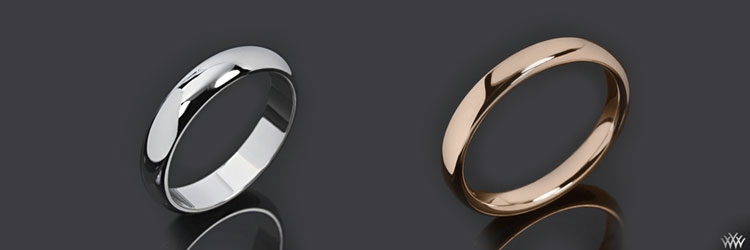Metals are highly lustrous because they have an abundance of free electrons. It is complicated chemistry to understand how electrons affect color, but I want you to have a basic understanding of it. Remember that all the light that is shone onto a material is either reflected, absorbed, or transmitted.
What happens is that the electrons in an atom are constantly moving around, vibrating. When certain wavelengths of light are absorbed by these electrons, what we see is the remaining transmitted colored light. We’ve visited this concept in the past when discussing why diamonds have a yellow tint, and why blue fluorescence makes a diamond appear whiter.
This same chemistry applies here to metals, and if all the components of white light are transmitted equally well by the metal, then that metal will appear silvery in color. This is the case with most metals. However, with gold and copper the components of white light are not all reflected equally well. For example gold does not transmit the higher energy levels of blue light as well and most of this is absorbed and this is why we see yellow.
The most common types of pure metal used in rings are silver, gold, and platinum. Their prices reflects the rarity of the metal as it occurs in nature as well as the demand for the metal. In jewelry, pure silver and gold are not normally used to make rings because as a pure metal, they are too soft for producing jewelry such as rings. Rather, metals are often combined together as alloys to increase the hardness of the metal.
Examples of alloys are sterling silver, white gold, and rose gold. Let me start with sterling silver.
Sterling Silver
Sterling silver has a minimum purity of .925 or 92.5% and distinguishes it from fine silver, which is the .999 or 99.9% pure metal. Sterling silver is most commonly made by alloying silver and copper. Sterling silver has what can be described as a greyish-white color and when polished is highly lustrous. But because silver has a natural tendency to tarnish it can look dull over time, especially if you forget to polish it. You will find that modern versions of sterling silver will have additives in it to improve its resistance to tarnish. Many cheaper simulant diamond rings will be set in sterling silver and identifying the silver setting is an easy way to deduce that the stone is not a diamond.
Yellow Gold
Because I discussed this at the beginning, you will know that pure gold is naturally yellow in color. You will also most likely have heard of the word ‘karat’ (k) when describing gold, but you should not confuse it with the word ‘carat’. A karat is a measure of the purity of gold whereas a carat is a measurement of weight we use in diamonds representing 0.2 grams. Pure gold has a purity of 24 karats or 24k.
Yellow gold alloys are available in 22k, 18k, 14k, 12k, and 10k. All you need to know is that 22k is still too soft for jewelry, and 12k is not good looking enough for jewelry. Also interesting is that below 10k is illegal to be sold as real gold in the US. This is why you will only find 18k and 14k yellow gold in rings.
Now 18k gold is much more expensive than 14k gold because it has 16.7% more gold in it. But we have also seen that more gold does not necessarily mean better for jewelry. The fact is that 14k gold has better durability than 18k gold. Remember that the additives are put in to harden the metal and a harder material is more resistant to scratches.
White and Rose Gold
Many people don’t realise that white and rose gold are simply gold alloys. They are actually made by changing up the composition of the alloys. For example, 18k White Gold can be made by adding 25% platinum or palladium to the 75% gold. This is why white gold is more expensive than yellow gold and has a color that is very similar to platinum. You can make rose gold by alloying gold with silver and copper. For example, 14k rose gold can be made with 58% gold, 10% silver, and 32% copper. This is why rose gold is less expensive than yellow gold.
Platinum
Platinum is desirable because it has a natural white luster. Also, because platinum is harder than gold, it makes it possible to make jewelry using a higher purity. However, the pure metal is again still too soft. The most common purity of platinum in jewelry is .950 (95%). The other 5% is commonly iridium, ruthenium or cobalt. Now of all these, iridium is the softest and cobalt is the hardest. On Mark Morrell’s website, he explains that his preferred platinum of choice is a 0.900 mix of platinum (90%) and iridium (10%) because it is of:
“upper-medium hardness – resists dents and dings well – is reasonably malleable – and requires less pressure to be imposed on a stone in the setting process than the harder alloys – is about as resistant to scratching as the 950 ruthenium blend and features all of the longevity that platinum is renowned for. This alloy works extremely well for both casting and hand fabrication.”
Mark is a well-respected artisan of custom-made platinum jewelry. With his advice summarising all of the important points to note when picking out a metal to use in your ring, especially if it is a custom-ring, as the costs will likely depending on the material as well as how difficult the metal is to work with.
Prongs
Now that we know a bit about the metals used in jewelry, we can use this knowledge and apply it to our choice of prongs. Ideally, we want prongs that will reduce the risk of damaging the diamond when you bang it against something by accident. This means that it is better to have a softer material for the prongs because less energy would be transferred to the diamond on impact. A frequently asked question is whether white gold or platinum is better for the prongs.
From our discussion above, we can conclude that platinum is harder than white gold. Of course, a softer material means that the metal itself is easier to damage. This matches the typical advice that white gold prongs are safer for the diamond. Remember that platinum has a natural white lustre, so you will find that the typical advice out there is that the diamond will appear slightly whiter with platinum prongs.
Another frequently asked question about prongs is whether to have 4 or 6 prongs. Now there are several considerations that I will try to summarise for you now. A four-prong setting is said to let more light into the diamond. However, there is an interesting counter-position to this and that is that with four prongs, each prong has to be larger and so from the face-up, it seems that the six prongs are less distracting.
The most important benefit of having 6 prongs is that even if one of the prongs break, you will still have 5 prongs securely holding the diamond so that it won’t fall out. However, if you only have 4 prongs, then there is a very high chance that the diamond will become loose and fall out if one of the prongs break.
Other considerations are that with four prongs, the diamond will take on more of a squarish appearance, whereas with six prongs, the diamond will look more round. As an added benefit, a diamond set with six prongs will actually look bigger. One thing I have noticed with my fiancé’s ring that has six prongs is that 1 of the prongs was set on an arrow head. The problem with this is that not only does the prong cover one of the larger virtual facets of the diamond, but the reflection of the prong can be seen on the arrow shaft.
The lesson to learn from this is to ensure that you ask if the jeweller can set the prongs where it doesn’t cover the arrows, and if this bothers you then perhaps you should consider having four prongs instead. Having to consider the setting of the prongs in relation to the arrows also limit the ability to have the prongs set to cover any edge inclusions.
Conclusion
So there you are, you are now one more step closer to finding your perfect ring. The key factors when picking out the type of metal or prongs for your diamond setting are appearance, durability, safety, and ease of working with if you’re making a custom-made ring.
One last thing is regarding allergies. Although high purity silver, gold, and platinum are hypoallergenic, be sure to find out any potential allergies of the receiver of the ring. Do your best to minimise any risks and don’t underestimate the importance of safety and peace of mind when purchasing a ring. This is why I also recommend getting insurance for your entire ring, but that’s for another tutorial. Trust me, your future fiancé will thank you for considering all of this and it will make your ring that much more special.



